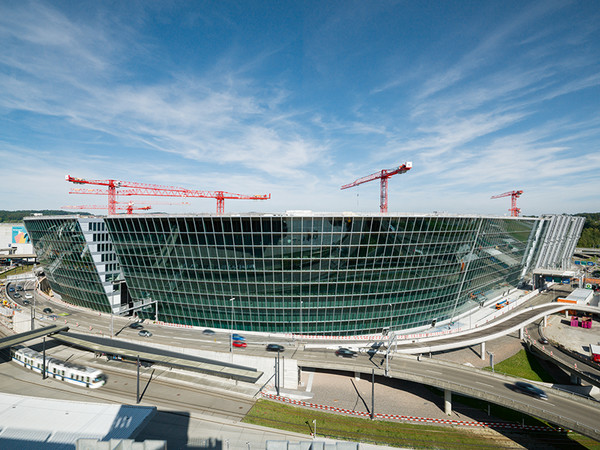Autonomous drilling robot
An ABB industrial robot is the centrepiece of an autonomously operating robot installation system. As a result, Schindler has for the first time automated the installation of lifts in cramped lift shafts.
To install the guide rails and access doors of a lift, anchor bolts have to be sunk in the lift shaft – the higher the conveyance height, the more needed. An ABB industrial robot (type IRB 2600) takes on the strenuous drilling of holes in the concrete and placing the bolts in an autonomously working system for the installation of lifts.
Its range of 1.65 m with a load-bearing capacity of 20 kg makes it ideal for this task. Furthermore, it works reliably under the adverse conditions of a lift shaft.
Autonomous installation system
The "Robotic Installation System for Elevators" (R.I.S.E), jointly developed by the lift manufacturer Schindler together with ABB Robotics Switzerland and the ETZ Zurich, is intended to relieve lift fitters of physically demanding work. The primary task of the robot is to drill holes and place anchor bolts in the lift shaft.
But the idea behind the robot is even more ambitious: the developers have created an autonomous installation system that pushes itself from floor to floor via an automated winch - and thereby, according to its developers, breaks completely new ground. R.I.S.E was deployed for the first time under everyday conditions during the installation of the lifts in the building project "The Circle" at Zurich Airport.
Robot works flexibly in the shaft
 R.I.S.E was deployed for the first time under everyday conditions during the installation of the lifts in the building project The Circle at Zurich Airport. Photo: © Schindler Aufzüge AG
R.I.S.E was deployed for the first time under everyday conditions during the installation of the lifts in the building project The Circle at Zurich Airport. Photo: © Schindler Aufzüge AGIn R.I.S.E the robot is attached to a platform that pulls itself upwards and caulks in the lift shaft via a winch system. One difficulty is that programming the robot to always drill with millimetre accuracy at exactly the same coordinates was not simple. It is always placed differently in the lift shaft and therefore has to adjust its drilling coordinates dynamically.
The drilling points are admittedly in general prescribed, but the robot scans the shaft wall additionally to discover whether there is a reinforcement rod behind it or whether the concrete surface is uneven. The installation system calculates tolerance limits on the basis of algorithms and then drills the hole offset.
Outwitting the robot controller
"To guide the robot arm precisely to the drilling points for each new zero point in the three-dimensional space, we had to outwit the robot controller as it were, since it is not designed for this," explained Christian Studer, Head New Technologies at Schindler. After the drilling – during which sensors also check whether the drill hole was realised correctly – the robot hammers in the anchor bolt.
A camera is installed on the platform for remote monitoring and all drilling data are logged, but the system in general operates autonomously and therefore does not need any external monitoring and control. It can be introduced into the lift shaft and carries out its work independently round the clock until all anchor bolts have been placed.
Prototype in successful operation
The system has now been used in several new lift installations. According to Studer, the sturdy robot did not fail once on these occasions. The R.I.S.E, including the robot technology of ABB, has already received an important award: the Council of Tall Buildings & Urban Habitat gave it an "Award of Excellence" in the "Innovation" category in April 2019 in Shenzhen at the Tall+Urban Innovation Conference.
Schindler is very pleased with the new automation solution, "There is a lot of discussion about automation in the building industry. Thanks to their geometrically simply structure, lift shafts are suitable for digital building. We can now bring digitalisation directly to the building site with this autonomous system," Studer concluded. In future, the lift company intends to make more use of the system based on an ABB robot.
More information: abb.de/robotics


























Write a comment